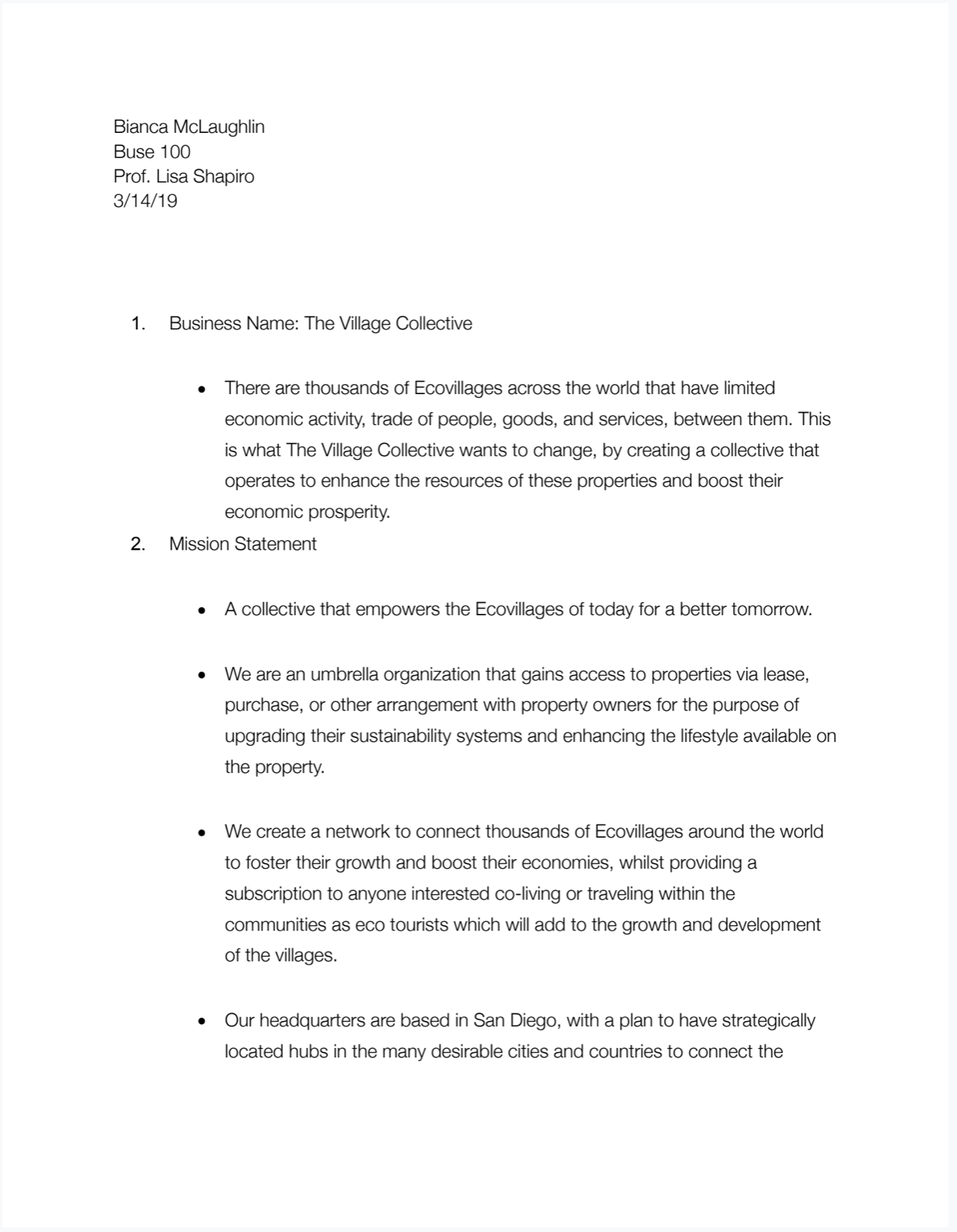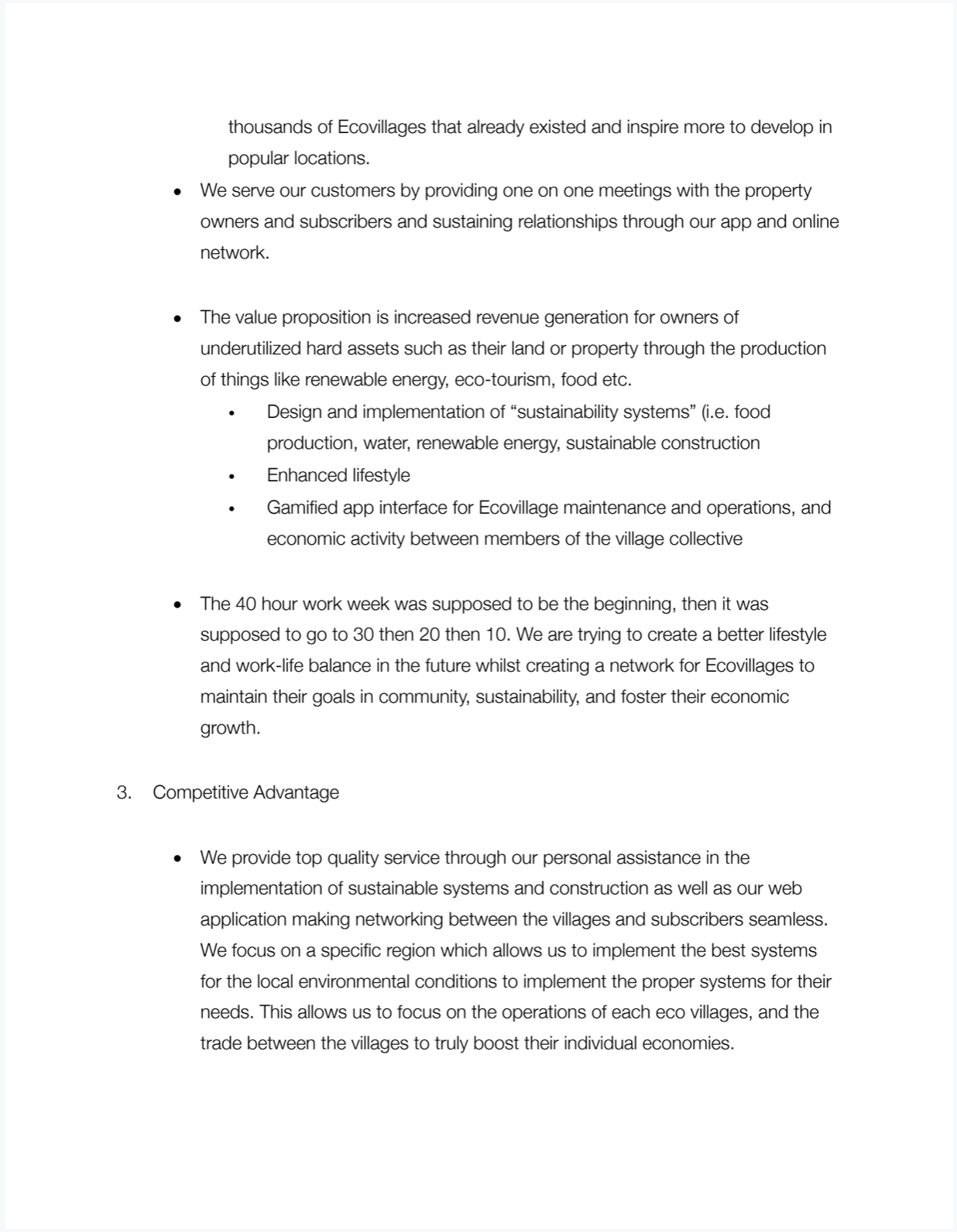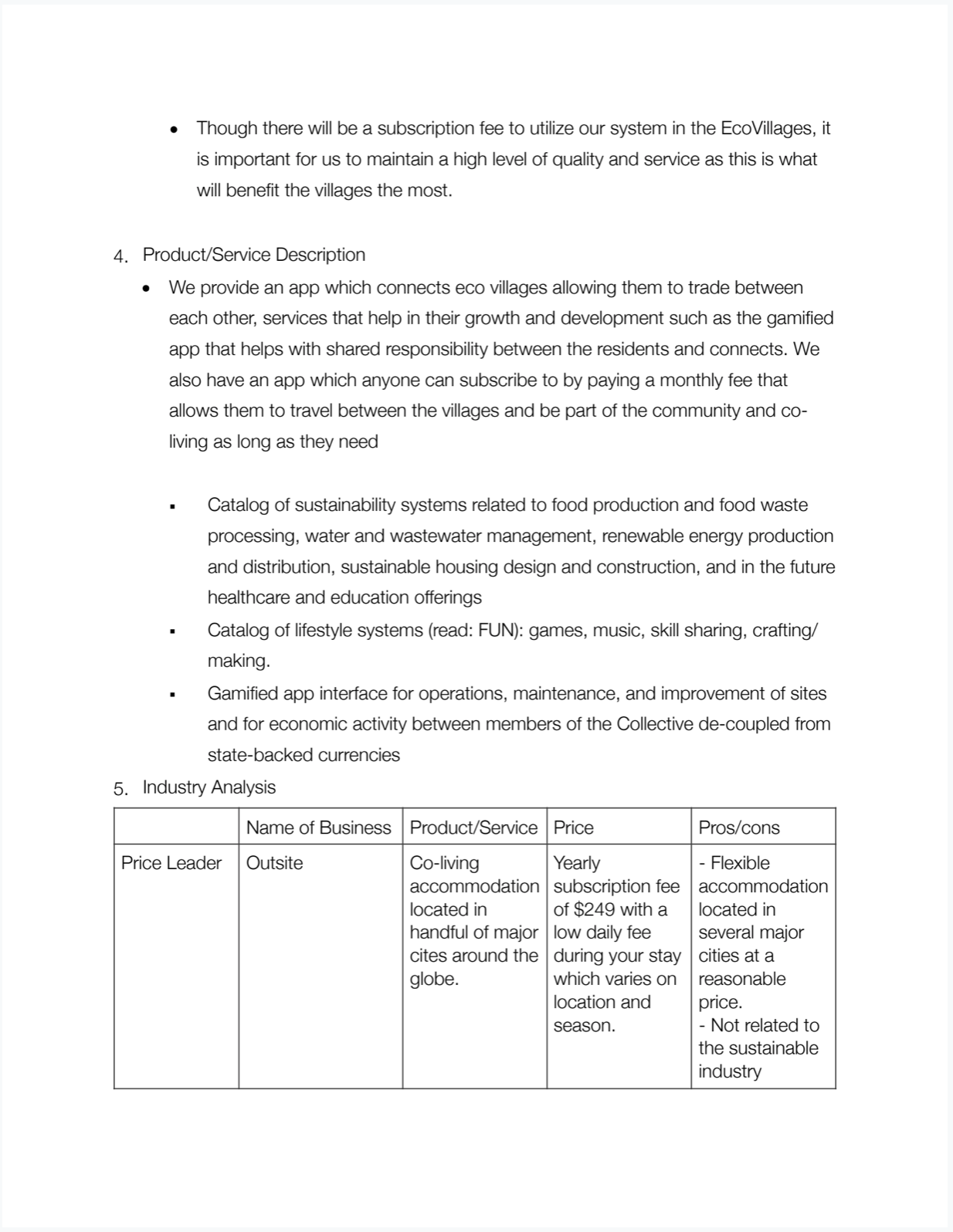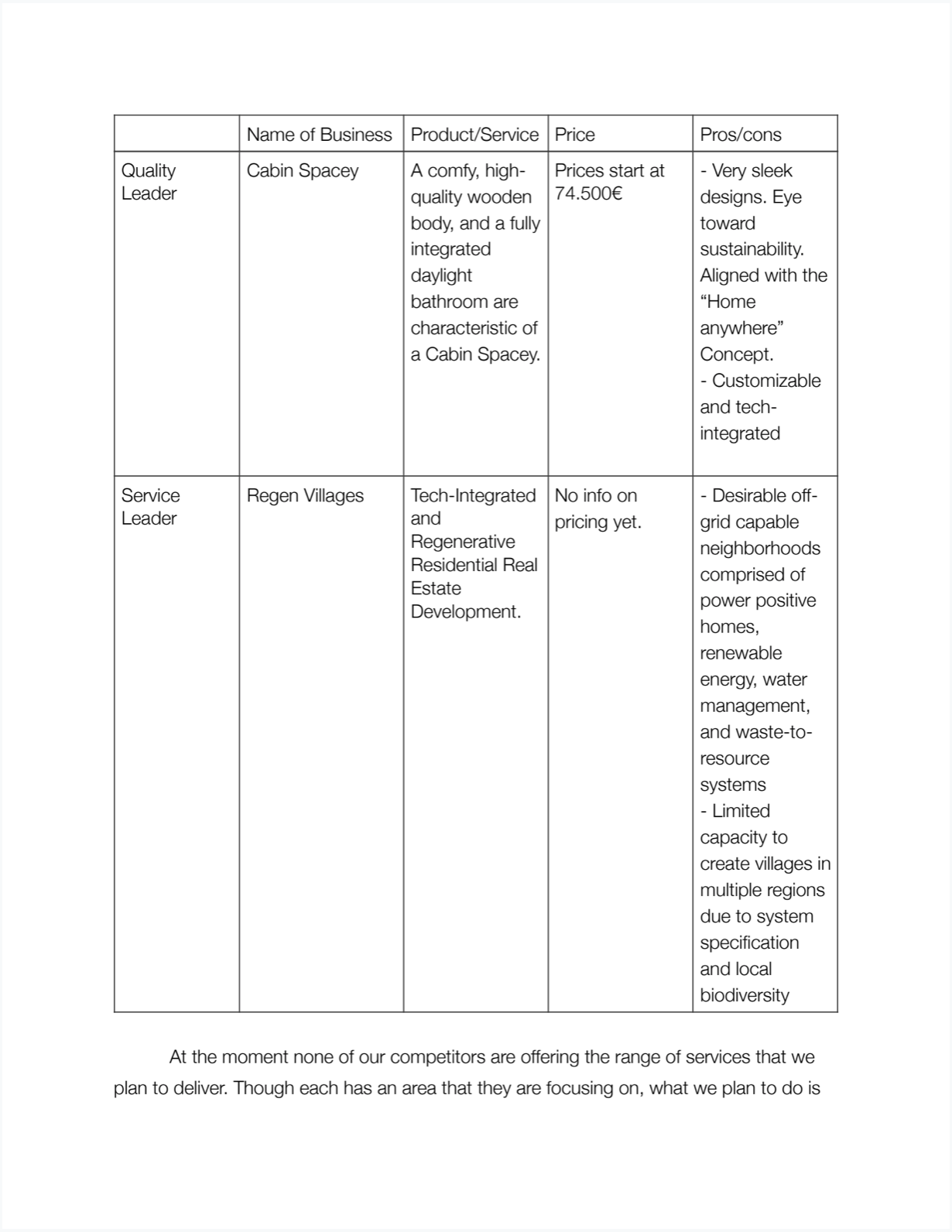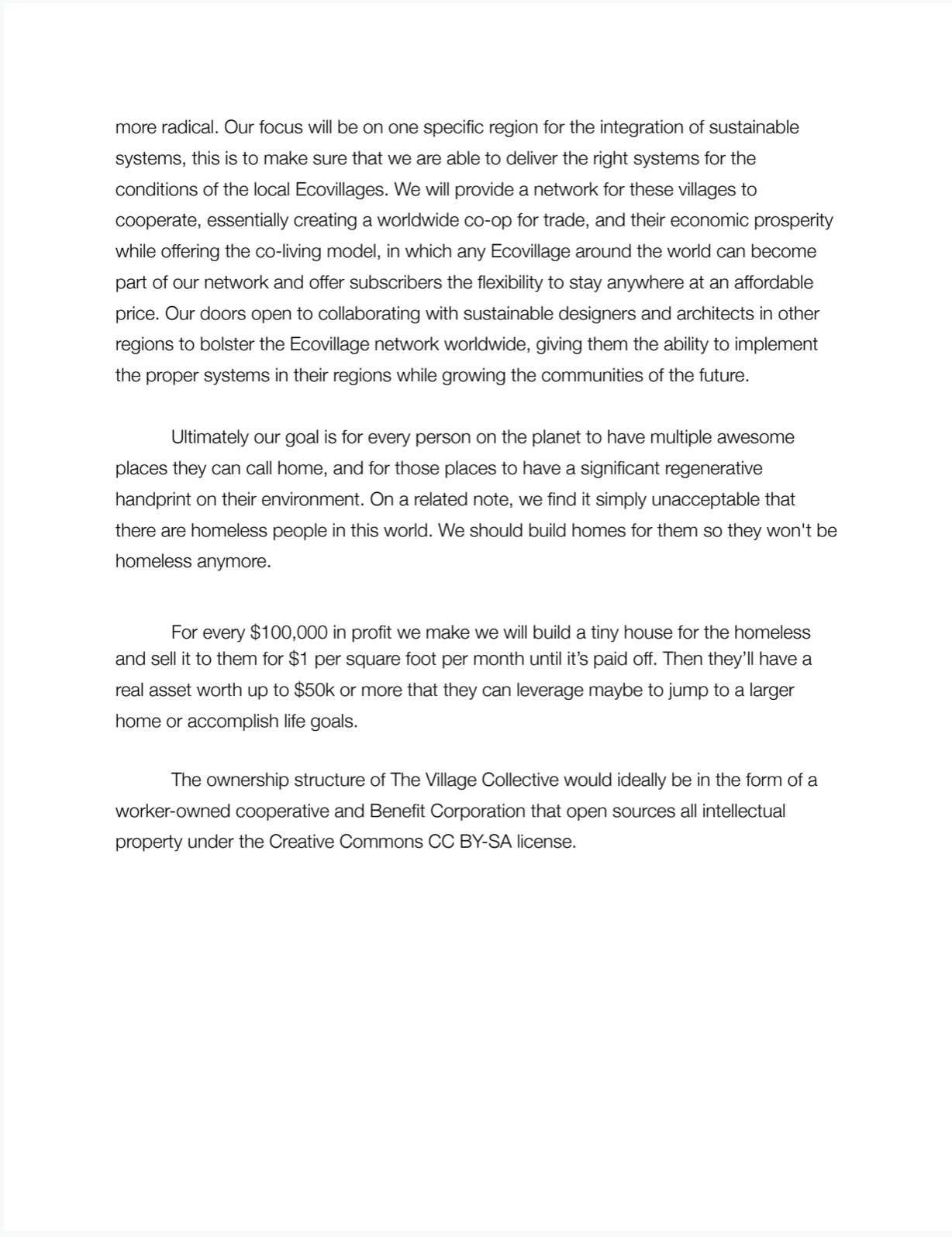The Village Collective
The Village Collective
Pay a subscription fee and get an amazing place to live in every country in the world
The idea of The Village Collective is to create a network of awesome places to reside or visit, create strong economic opportunity in those places with gamification, while also upgrading their sustainability systems. To continue the trend toward greater flexibility in this game called Life, and reverse the trend of increasing monotony, wage slavery, and unfulfilling lifestyles.
It could also be a powerful tool in redeveloping our economies so that they work for all life on this planet. The idea would have several components working together. 1) Offer property owners a service to help supplement their sustainability and social/lifestyle (read: fun) systems 2) A gamified app interface to facilitate the seamless operation of the community's "chores" and incentivize innovation and 3) A system of trade between residents and between villages.
* Village is the vernacular here but presumably, this could scale up to city level.
We think this could start with a network of "villages". These villages would be awesome places to live. They could be filled with adorable tiny houses, earthen domes, and straw bale structures; or maybe even 3D printed houses using local earthen materials and sprayed with bacteria to turn CO2 into limestone… who knows. There are natural swimming pools, the freshest foods you will ever eat grown right outside your door prepared by incredible chefs that love what they do (and will happily teach you to love it as well). Plus there are interesting and fun people to enjoy the abundant recreational opportunities the villages would provide.
One benefit of being a member of the collective might be that you can trade living situations within the network. Say you want to live in Germany for 3 months on a whim (or for a job), if the collective gets big enough the hope is it would be able to accommodate that whim (or job placement). The bigger the network the quicker/more likely it will be able to fill that order/request. Think of it starting off like the dopest time share of all time but instead of being limited to 1 week, you get 6 to start, and more every single year as the network grows until you can pretty much go anywhere you want anytime of year. The network could be built both by buying properties and by convincing property owners to put their properties into TVC. They could put their spots in for as much or as little time as they wanted, keeping as much time as they want reserved for personal use, or Airbnb, weddings, whatever the space is good for.
Part of our competitive advantage would come from a series of tools related to the environmental impact and social value (read: fun) of the properties. As a service to the property owner TVC would provide a system of tools and operations related to composting, regenerative agriculture, biogas production, renewable electricity generation, localized recycling, advanced manufacturing/construction, personalized medicine, rainwater harvesting, human waste processing, and Net Positive housing design and construction. Individual members of The Village Collective could be incentivized through a gamified app interface to properly sorting and processing waste streams such as aluminum, glass, cardboard, food waste, and various types of plastic. One might also gamify things like cooking meals for other villagers, cleaning up around the villages, doing repairs, tending to plants and animals etc. They could earn credits that they could use to buy the fresh grown food, or other goods produced on site (or brought on-site from far away travelers), or to pay for services offered by other villagers. If a system like this were implemented properly it’s plausible that the operation of the village would seem to happen almost magically with few or no janitorial/maintenance staff necessary. I think we’re starting to see this with startups like Lime and Bird where the electric scooters almost seem to get recharged and stacked neatly on the corners without humans - I don’t know about you but it took a good while before I saw my first Bird catcher, although to be fair I don’t spend a lot of time in areas that have them - all through a simple economic incentive. Village The Game could also be setup to incentivize people to innovate and automate menial jobs like toilet cleaning out of existence. Like imagine someone solves the dirty toilet problem, maybe the society decides how much that is worth and he gets paid that in points over some period of time. Before when people would go to the bathroom and it was dirty they would get a notification on their phone offering the going-rate for that person to clean it, and now it asks if you’d like to leave a tip for the inventor that solved that problem. The inventor keeps receiving tips until the amount the society said his innovation was worth has been paid off.
Ultimately our goal is for every person on the planet to have multiple awesome places they can call home, and for those places to have a significant regenerative handprint on their environment. On a related note, we find it simply unacceptable that there are homeless people in this world. We should build homes for them so they won't be homeless anymore.
For every $100,000 in profit we make we will build a tiny house for the homeless and sell it to them for $1 per square foot per month until it’s paid off. Then they’ll have a real asset worth up to $50k or more that they can leverage maybe to jump to a larger home or accomplish some other life goal.
The ownership structure of The Village Collective would ideally be in the form of a worker-owned cooperative and Benefit Corporation that open sources all intellectual property under the Creative Commons CC BY-SA license.
Impressum
(fancy way to say legal notice or statement of ownership)
The Village Collective is an idea for a worker-owned Benefit Corporation. For every so $100,000 in profit we make we will build a tiny house for the homeless. To the extent it has the legal power to do so Corona Enterprises places the idea and all associated intellectual property into the public domain under the Creative Commons CC BY-SA license for use by anyone working to make Net Positive housing a reality for every person on the planet.
"[We use] a simple formula based on the principle that a person's % share of the equity should always be equal to that person's share of the at-risk contributions.
At-risk contributions include time, money, ideas, relationships, supplies, equipment, facilities or anything else someone provides without full payment of it's fair market value. Every day people contribute more and more to a company in hopes that it will someday generate a profit, go public or sell. Because contributions are constantly being made, the model is dynamic. It self-adjusts to stay fair.
There are two basic types of contributions. Cash contributions consume cash, non-cash contributions do not. Time, for instance, is a non-cash contribution whereas an reimbursed expense is a cash contribution. Slicing Pie normalizes cash and non-cash contributions by converting to a fictional unit called a "Slice". A slice represents a normalized at-risk contributions. A slice is kind of like a poker chip.
An individuals % share = individual's Slices ÷ all Slices
At any given time, the above formula will provide a perfect equity split. The formula applies until the company breaks even or raises enough capital to pay participants for their contributions. At this point the split "freezes" and subsequently determines the distribution of dividends or the proceeds of a sale.
ot only does Slicing Pie determine a perfect equity split, but also it will help you calculate a fair buyout price, if any, when someone leaves the company before breakeven.
Slicing Pie is used by entrepreneurs all over the world. The books, videos and content below provide detailed instructions on making the model work for your company. Slicing Pie is the fairest way to split equity on the planet!"
http://slicingpie.com/learn-slicing-pie-model/



